Lately, I find myself tangled up in unhelpful thoughts about the future. Sometimes, an almost overwhelming feeling of dread and apprehension if I’ve been thinking too hard. When I was facing personal problems, and self-doubt in relation to work and careers in the past, I reached for a book by Adrian Shaughnessy; How to be a graphic designer without losing your soul. It helped reaffirm my choice to study graphic design and my goal to enter the creative industry with a better understanding of integrity.
Again, I have been facing some self-doubt and uncertainty, and felt the need to retreat into the library for some advice. One of the books I pulled out and decided to check out also happened to be edited by Adrian Shaughnessy.
The book I picked up is named Studio Culture. It shares an understanding of many different founders of graphic design studios and those who are work within them.
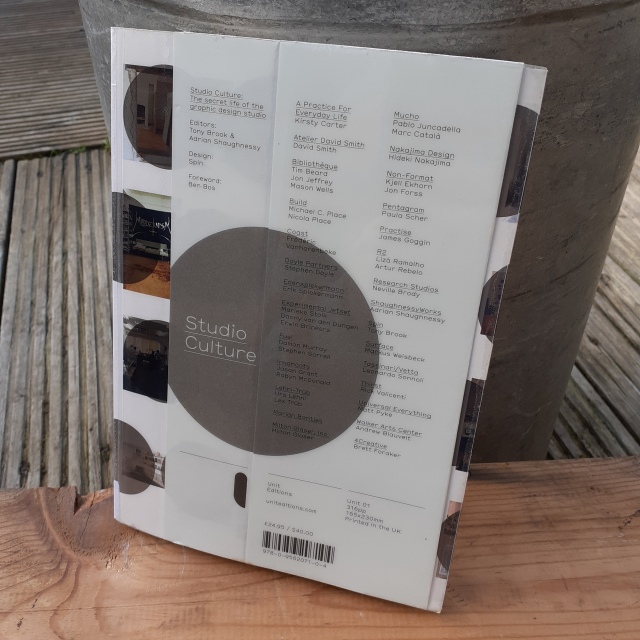
Here is the book’s blurb:
Studio Culture provides a unique glimpse into the inner workings of 28 leading graphic design studios. In a series of penetrating interviews, the secret life of the studio is revealed, and the mechanics of building and maintaining a vibrant studio culture are laid bare with disarming frankness.
Even flicking through the book casually in the library before checking it out, I really felt the sincerity, and was surprised how direct the interviewees were. It felt like the image I had of design studios were now incongruent with the reality of these studios, so I had to borrow the book.
You see, I am both exited and nervous for a short work placement in a graphic design agency that I will be attending abroad in the near future. I don’t feel that the studios on campus are an accurate reflection of real-wold work ethos or camaraderie of a modern studio (sorry!) and I feel the need to better acquaint myself with what to expect in a healthy studio.
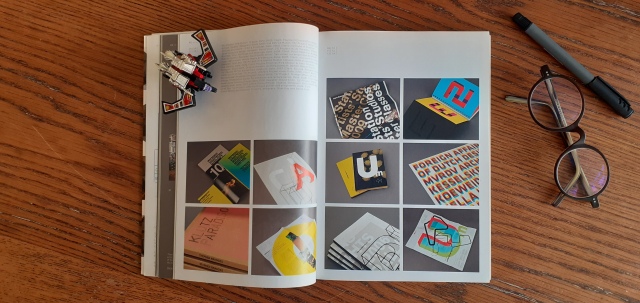
As stated in the blurb, the book shares with the reader insight to 28 different studios across the globe. Each studio is given a chapter to itself in which contains an interview; each interview is either conducted in-person, over the phone, or through e-mail.
The presentation of the written information is easy to digest. We’re given the studio’s names, the year they’re founded, the number of personnel at work, the location of the studio, and their web domain (at the time of printing). Each studio is given a short bio, and there’s some photography of the interior (and sometimes and exterior) of the studios, which is much appreciated, although most of these images are printed very small. Each studio shares work from past projects as a spread of images.
Here’s an excerpt of a conversation held between Shaugnessay and Urs Lehni of Switzerland-based studio Lehni-Trüb:
Were you inspired by any studios?
That’s a difficult question to answer. We could respond by dropping a bunch of names of designers and studios, but I think we were much more interested in certain attitudes and forms of practice. As examples we could name a certain approach in recent book design from the Netherlands; conceptual art of the late 1960s; or some playful manifestations of design in Italy during the 1970s: although there are just commonplaces for many designers…
What I like about your work is its lack of showiness – the absence of graphic effects and tricks. This makes it hard to detect your stylistic influences. In what way do the three influences you mention above inspire your work?
We doubt big ideas and concepts. As soon as something becomes too slick, we try to saw one leg off to unbalance it again. We like ambivalence more than clarity. Maybe this results from a lack of security and the lack of a serious attitude, or maybe it is simply questioning the recurring demand to always be inventive and unique. Deception, appropriation and imitation are helpful strategies to find our way out of this, in equal measure good and bad.
All of the interviews (regardless of the information channel) feel genuine and feel valuable.
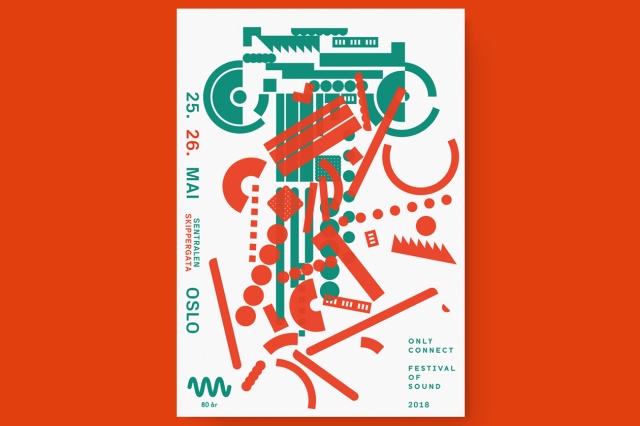
Early in the book, Shaugnessay makes a point about our workplace needing to be considered in order for us to do our best work. There’s a lot of focus on the psychological hygiene of a studio.
The types of people in the workspace are considered and Shaugnessay shares personal mistakes in employing certain folk:
When I first started hiring designers, I made some terrible mistakes by employing designers purely on the strength of their work. I hired people who had impressive portfolios but whose human characteristics were sometimes less impressive. These were talented people who needed a lot of maintenance; in other words, they were people who needed to be told what to do.
Shaugnessay believes that modern studios are non-hierarchical and democratic, and as such, ‘telling people what to do’ doesn’t fit. His view being that the competent design studios will work on the notion that ‘the boss is dead’; the contemporary studio is a place of equality. But he also mentions the existence of studios running on an autocratic model. Because of course there would be.
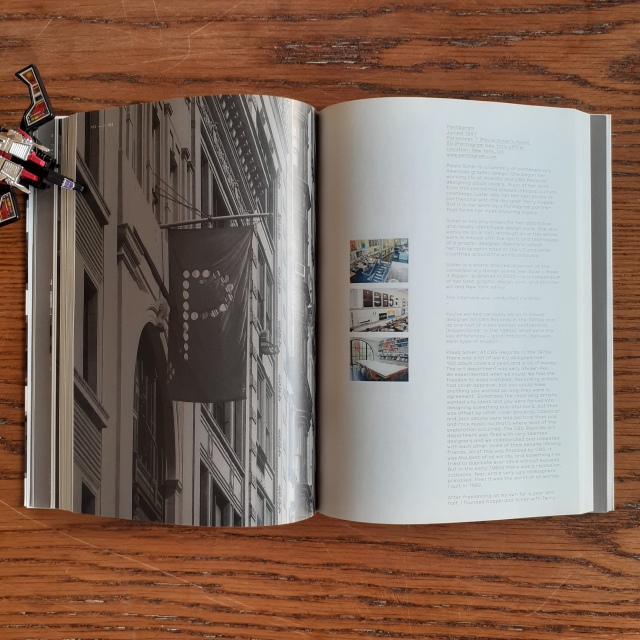
…it is mentioned that the ‘virtual studio’ already exists. There are studios who are based in different locations such as Non-Format and Universal Everything, and carry out tasks without hinderance through modern communications technology.
With all the advancements of digital platforms to craft work, I am glad to hear that the hand-made is respected. Shaugnessay explains:
An area for making things with our hands is often considered unnecessary in todays all-digital studios. This is a mistake. Design suffers when it loses contact with it’s made-by–hand artisan roots. No matter how small the studio, we should try to find space for an area where things can be made, cut, distressed, painted and built. An area for photography is equally useful.
We’re also informed that in the studio everyone should be respected. This includes cleaners. Such a statement seems to be ‘obvious’ – a basic understanding of respect for different tasks different people carry out – but if you’ve ever worked in a place where there has been a clear hierarchy of ‘most valued to least valued persons’ with clear inequality of respect and appreciation, then you’ll know that it has the potential to damage interpersonal relationships and cripple work ethic.
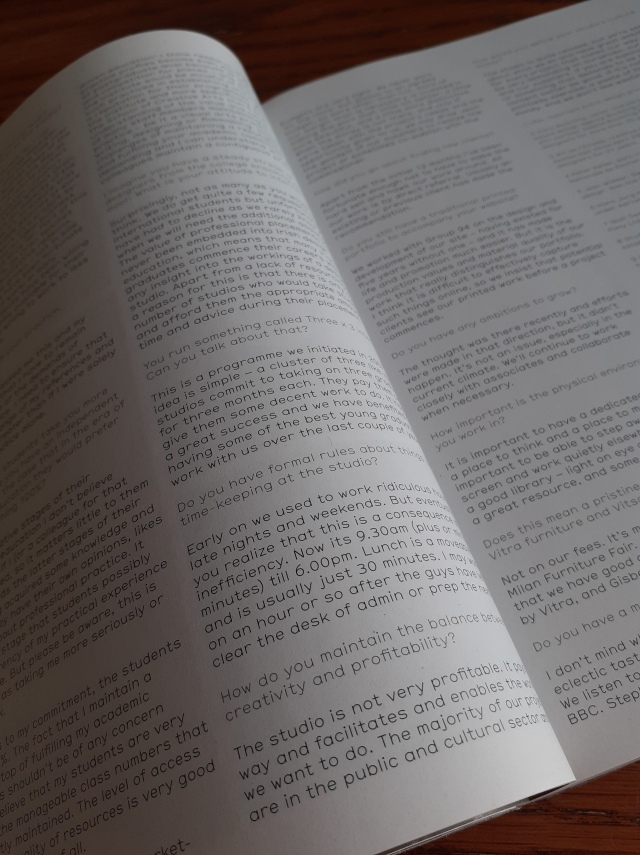
In regards to the physical characteristics and design of the book, I liked the lightweight, matte paper used. But my eyes did not appreciate the tiny type and I would have liked for some of the images to have been larger (I wanted to better appreciate the interiors and exteriors of the studio photographs). Of course, the book would have been much thicker if it were given a larger size font; it’s already quite dense at over 300 pages.
This book was first printed back in 2009, but I feel that the contents are still relevant as of writing. I’d recommend this book to all students studying graphic design who are preparing to enter the creative industry. It will aid in getting a better grip on the structures of modern studios, and what to expect when working in them.
I can appreciate your retreat into the library, books are stability, ever ready, and always happy to inform. You can never know how a new place will be, until you’re there, but getting an insight into different working studio environments through the books, will surely help you to relate, recognise, the situation you find yourself in, a bit like bird spotting, knowing which bird you have in your sights. 👀
LikeLike
Yes, I realise that studios overseas are much different than here, but now I have a little better understanding before I see any studios abroad, I feel a little more comfortable!
LikeLike